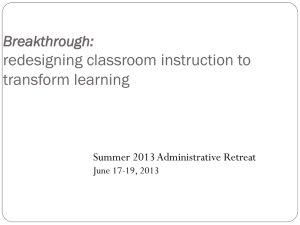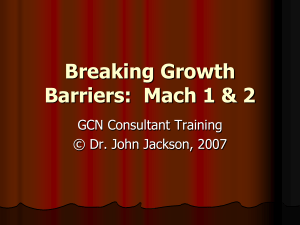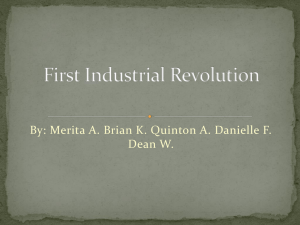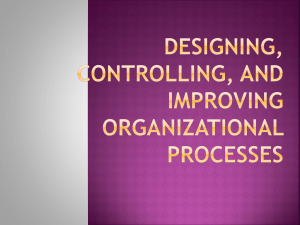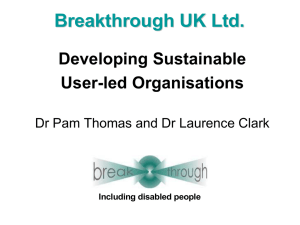Breakthrough project - BI Norwegian Business School
advertisement
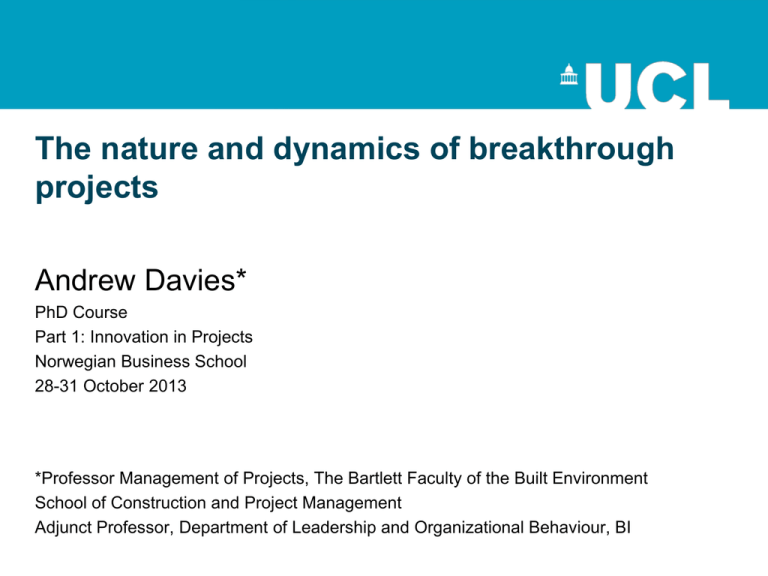
The nature and dynamics of breakthrough projects Andrew Davies* PhD Course Part 1: Innovation in Projects Norwegian Business School 28-31 October 2013 *Professor Management of Projects, The Bartlett Faculty of the Built Environment School of Construction and Project Management Adjunct Professor, Department of Leadership and Organizational Behaviour, BI • The innovation balancing act: exploration and exploitation • Learning from breakthrough innovation • Group work: breakthrough projects The innovation balancing act • “Pressures to innovate confront businesses as well as people with another demanding balancing act: keeping up with the activities we are already committed to, to reap the benefits of our investment in them, while at the same time starting new activities that will be of benefit in the future. While caught in the mainstream, we must also generate ‘newstreams’” – Rosabeth Moss Kanter When Giants Learn to Dance (1990) • March (1990) – Exploratory learning – Exploitative learning Types of projects Mainstream projects Transfer of capabilities across similar projects Support the momentum behind a company’s existing business Focused on existing customers’ needs and established technologies Existing business develops a reputation for ‘doing what it does best’, repeats certain types of projects by exploiting specific products, contingencies and programmes (Mintzberg 1983:27). Newstream projects Innovation and renewal of capabilities No experience base Breakthrough initiatives in technologies, products, processes, and services Breakout into new technologies and markets is led by: Breakthrough project (Tushman & O’Reilly, 2004) Rosabeth Moss Kanter (1990) When Giants Learn to Dance Organising for breakthroughs • “Most successful enterprises are adept at refining their current offerings, but they falter when it comes to pioneering radically new products and services” – • O’Reilly and Tushman (2004) ‘The Ambidextrous Organization’, Harvard Business Review Two types of organisational units: – – Exploitative units: make steady improvements in existing business – incremental innovations Exploratory units: breakthrough projects – radical innovations beyond current products or markets Functional designs integrate teams into the existing organisational and management structure Cross-functional teams General Manager Mfg Sales operate within the established organisation but outside the existing management hierarchy General Manager R&D Mfg Sales R&D Emerging Business Unsupported teams are set up outside the established organisation and management hierarchy General Manager Mfg Sales R&D Emerging Business Ambidextrous organisation establish project teams that are structurally independent units, each having its own processes, structures and cultures, but are integrated into the existing management hierarchy General Manager Existing Business Mfg Sales Emerging Business R&D Mfg Sales R&D Scope of ambidexterity Alignment of: Exploitative Business Exploratory Business Strategic intent cost, profit innovation, growth Critical tasks operations, efficiency, incremental innovation adaptability, new products, breakthrough innovation Competencies operational entrepreneurial Structure formal, mechanistic adaptive loose Controls, rewards margins, productivity milestones, growth Culture efficiency, low risk, quality, customers risk taking, speed, flexibility, experimentation Leadership role authoritative, top-down visionary, bold Ambidextrous Leadership Different alignments held together through senior-team integration, common vision and values, and common senior-team rewards • The innovation balancing act: exploration and exploitation • Learning from breakthrough innovation • Group work: breakthrough projects Learning from projects • Learning from projects is difficult – Temporary, teams disband when project finishes – But improved project performance depends on learning • ‘Every project creates a unique learning opportunity. Things change rapidly, decisions are constantly made, and mistakes are made. Lessons can be learned every week and at every milestone, and clearly at project completion. But few organizations have a habit of recording, documenting, and sharing project lessons throughout the company’ – Shenhar & Dvir Reinventing Project Management (2007: 212) The challenge of learning: capturing and transferring knowledge • ‘Company executives and CEOs should install a learning culture around projects. • It should become a habit to summarize lessons learned in each opportunity or major event and to document a completed project (whether a success or failure) with a summary report describing the lessons learnt. • This report should be prepared after all team members have shared their thoughts during a long discussion about what went right or wrong and why, and then it should be distributed to the rest of the company, perhaps on its intranet. • In this way the company will retain its organizational memory and will be able to avoid repeated failures of the same kind’ – Shenhar & Dvir (2007: 212) Project capability base of the firm New Newstream projects Newstream projects Technology base Existing Mainstream projects Newstream projects Existing New Market base Adapted from Davies and Hobday (2005) Breakthroughs: the challenge of moving a firm’s capability base • Breakthrough projects for fast-emerging technologies or rapidly changing or new customer needs • Outside a firm’s project experience • Relying on detailed project plans will give a false sense of security • Do not require the same resources as maintstream projects • Bring greater risk and uncertainty • Managers need to be creative and rely on improvisation and intuition Breakthrough projects • • Learning from breakthrough innovation Starts with a “vanguard project” – Davies and Brady (2004) – • “…established at the forefront of an organization to explore strategic opportunities to move into new technology or market bases or adapt to a changing market environment. Vanguard projects lead the way by anticipating progress as well as gaining experience about a new activity. They are often set up as a separate pilot group to explore a new opportunity on a trial basis and to provide room for new ways of thinking and acting at a distance from the mainstream organization”. p1607, Brady and Davies (2005) Dealing with tensions and transitions – – Bottom-up learning from projects and top-down strategic learning Transition from exploratory and exploitative learning Breakthrough innovation: vanguard project and learning Project 4 Project a Project 2 Project b Vanguard project Project 6 Project 3 Project c Project 5 • The innovation balancing act: exploration and exploitation • Learning from breakthrough innovation • Group work: breakthrough projects Group work: breakthrough projects Each group examines one breakthrough project Develop a presentation (10 mins) Each group answers the following questions: 1.Describe the innovation associated with the breakthrough project? (product, service, process; driven by opportunity or customer needs) 2.How was the breakthrough project organised? (team structure, process for dealing with uncertainty) 3.Which organisations benefited from the project? 4.How did they capture and transfer learning? (build capabilities, etc) Literature: – – – – Davies and Brady (2000); Brady and Davies (2004) 2.1 R&D and new product development 3.1 Project teams 5.2 Integrated solutions business models

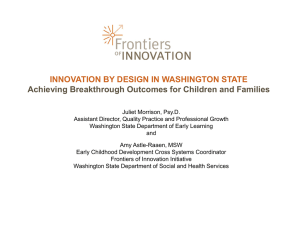

![PK_handbook_2013[3] - Breakthrough Magnet School](http://s3.studylib.net/store/data/009048781_1-7b38251da69229c11277314019591a1b-300x300.png)
